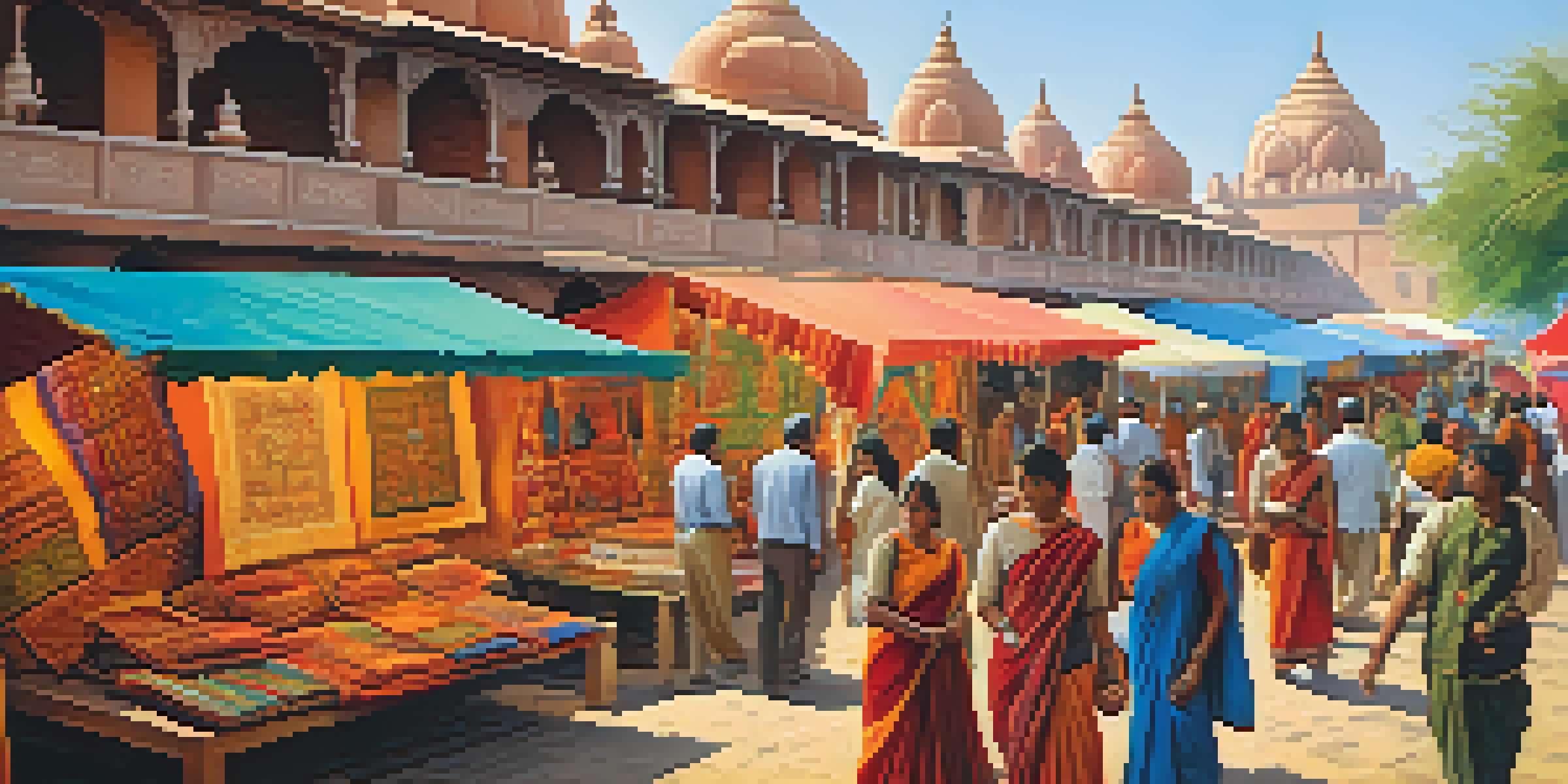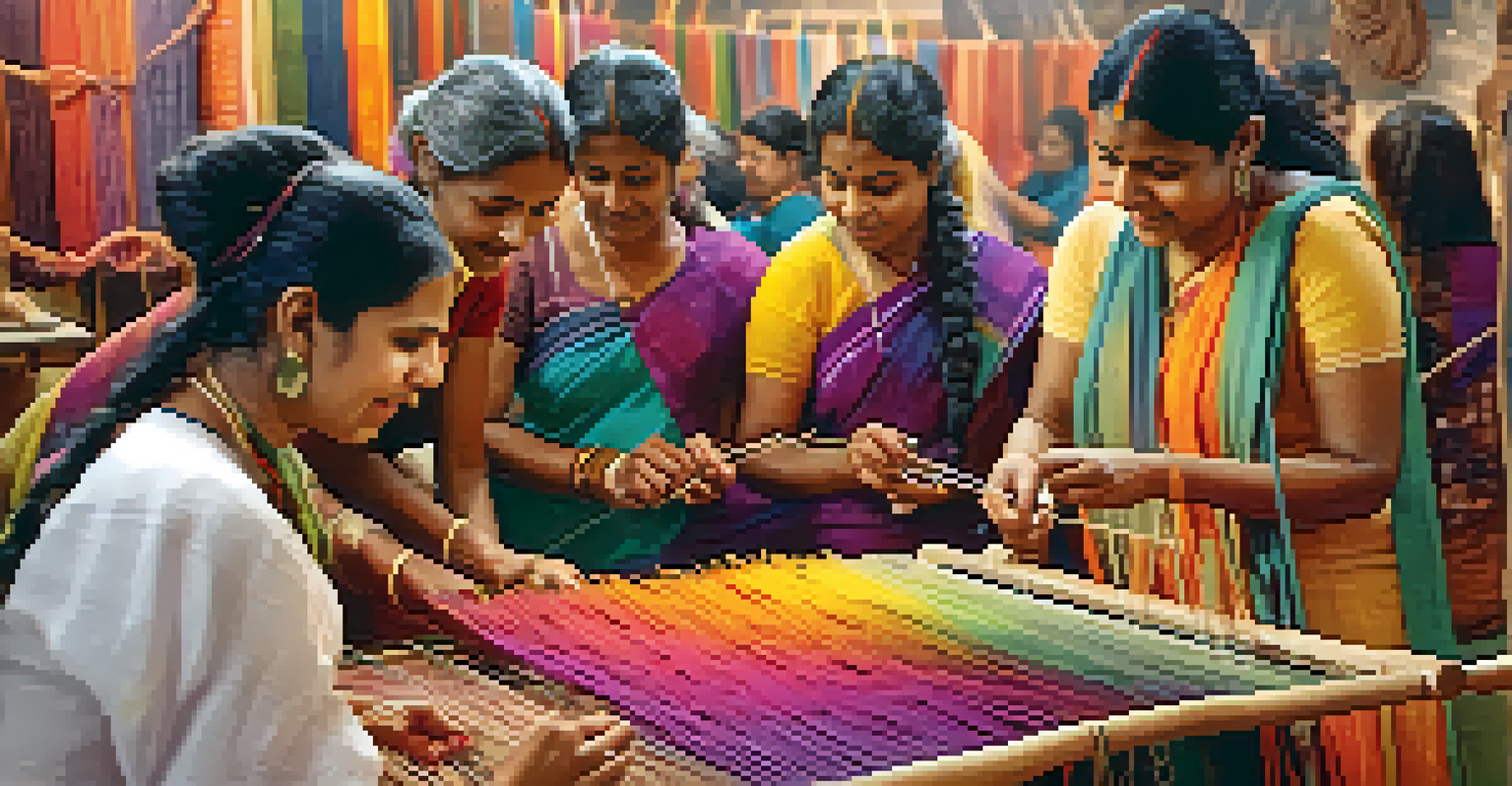Exploring the Rich Heritage of Indian Art and Craft Fairs

The Cultural Significance of Indian Art and Craft Fairs
Indian art and craft fairs serve as vibrant platforms where tradition and creativity intertwine. They celebrate the diverse cultures and histories of various regions, showcasing everything from intricate textiles to exquisite pottery. These fairs not only highlight the craftsmanship but also foster a sense of community and belonging among artisans and visitors alike.
Art is a collaboration between God and the artist, and the less the artist does the better.
Often rooted in centuries-old practices, these fairs allow artisans to share their skills and stories, passing down knowledge through generations. By participating, they contribute to the preservation of their cultural heritage while introducing new audiences to their art forms. This blend of tradition and innovation is what makes these fairs so unique and engaging.
Moreover, these events provide an excellent opportunity for visitors to experience the richness of Indian culture firsthand. Attendees can explore stalls, engage with artists, and even participate in workshops, making it a hands-on learning experience. Such immersive encounters deepen appreciation for the artistry involved, making these fairs a must-visit.
Diverse Art Forms on Display at the Fairs
One of the most exciting aspects of Indian art and craft fairs is the incredible variety of art forms showcased. From the vibrant colors of Madhubani paintings to the intricate carvings found in woodwork, each piece tells a story of its own. This diversity not only reflects regional traditions but also personal interpretations of culture by the artists.

In addition to visual arts, craft fairs often feature performing arts, live demonstrations, and interactive workshops. This creates a dynamic atmosphere where visitors can witness the creative process in action. For instance, watching a potter shape clay or a weaver work on a loom can be both educational and inspiring.
Celebrating Indian Cultural Heritage
Indian art and craft fairs showcase diverse traditions, crafts, and stories, fostering community and cultural appreciation.
Such exposure to different art forms encourages appreciation for the skill and dedication involved in each craft. It allows attendees to recognize the hard work that goes into creating these beautiful pieces, fostering a deeper connection to the artists and their heritage. Ultimately, this variety enriches the experience for everyone involved.
Promoting Sustainable Practices through Art
In recent years, there's been a growing emphasis on sustainability within Indian art and craft fairs. Many artisans are now using eco-friendly materials and traditional techniques that have minimal environmental impact. This shift not only promotes responsible consumption but also helps preserve indigenous practices that have stood the test of time.
Creativity takes courage.
For example, artisans who create paper products often utilize recycled materials, while textile artists may use natural dyes sourced from local plants. By highlighting these sustainable methods, fairs are educating visitors about the importance of making conscious choices in their purchasing habits. This approach not only benefits the planet but also supports local economies.
Furthermore, promoting sustainability in art creates a ripple effect, encouraging more artists to adopt eco-friendly practices. As consumers become more aware of their choices, they can support artisans whose values align with their own, fostering a community that prioritizes both heritage and environmental consciousness.
The Role of Technology in Modern Craft Fairs
The integration of technology is transforming the landscape of Indian art and craft fairs. From social media promotion to online marketplaces, artisans are leveraging digital tools to reach wider audiences. This shift not only increases visibility for their work but also allows for better engagement with potential buyers.
Many fairs now incorporate virtual experiences, enabling people from around the world to participate. This has been particularly beneficial during challenging times, allowing artisans to showcase their crafts despite physical constraints. Virtual tours and online workshops can make it possible for anyone to explore Indian art from the comfort of their homes.
Promoting Sustainability in Art
These fairs emphasize eco-friendly practices, encouraging artisans to use sustainable materials and methods that benefit both the environment and local economies.
While technology enhances accessibility, it also presents challenges for traditional artisans. Balancing modern marketing techniques with age-old practices requires careful consideration. However, when done thoughtfully, this fusion of tradition and technology can lead to exciting new possibilities for both artists and audiences.
Fostering Community and Collaboration
Art and craft fairs are not just about the individual artisan; they also encourage community and collaboration among artists. Many fairs feature collective stalls where groups of artisans come together to showcase their work. This not only creates a supportive environment but also fosters innovation through shared ideas and techniques.
Collaboration can take many forms, from joint workshops to co-created art pieces. These interactions often lead to unique creations that blend different styles and traditions, enriching the overall artistic landscape. It showcases how art can unite people, transcending boundaries and fostering mutual respect.
Moreover, the sense of community extends beyond the artisans to include visitors and organizers. Engaging with local culture, participating in discussions, and sharing experiences help build lasting connections. These relationships contribute to a vibrant atmosphere that celebrates the spirit of collaboration and creativity.
Supporting Local Economies through Art Fairs
One of the significant impacts of Indian art and craft fairs is their role in supporting local economies. By providing a platform for artisans to sell their work, these fairs help sustain livelihoods and promote economic growth in their communities. Many artisans rely on these events to showcase their crafts and connect with potential buyers.
Additionally, art fairs often attract tourists, boosting local businesses such as hotels, restaurants, and shops. This influx of visitors can lead to increased sales and the creation of job opportunities in the area. It's a win-win situation where the local economy thrives, and artisans gain recognition.
Enhancing Community and Collaboration
Art and craft fairs create a collaborative atmosphere among artisans and visitors, enriching the artistic landscape and fostering lasting connections.
Supporting local economies through art fairs also fosters a sense of pride within communities. When residents see their culture and crafts being celebrated, it strengthens their identity and motivates them to preserve their heritage. This sense of pride can lead to initiatives aimed at further developing local arts, ensuring that traditions continue to flourish.
Experiencing the Vibrancy of Indian Art and Craft Fairs
Visiting an Indian art and craft fair is an experience like no other. The vibrant colors, the aroma of traditional foods, and the sounds of live performances create a sensory feast for attendees. Each corner of the fair offers something new and exciting, inviting exploration and discovery.
As you wander through the stalls, the chance to engage with artisans adds a personal touch to the experience. Hearing their stories, learning about their techniques, and understanding their inspiration brings the art to life in a way that mere viewing cannot. This interaction fosters a deeper appreciation for the craftsmanship involved.

Ultimately, experiencing these fairs is about more than just shopping; it's about connection, culture, and celebration. Each fair serves as a reminder of the rich heritage that India has to offer, inviting everyone to partake in its vibrant tapestry of art and craft. Whether you're a seasoned collector or a curious visitor, there's something for everyone to enjoy.